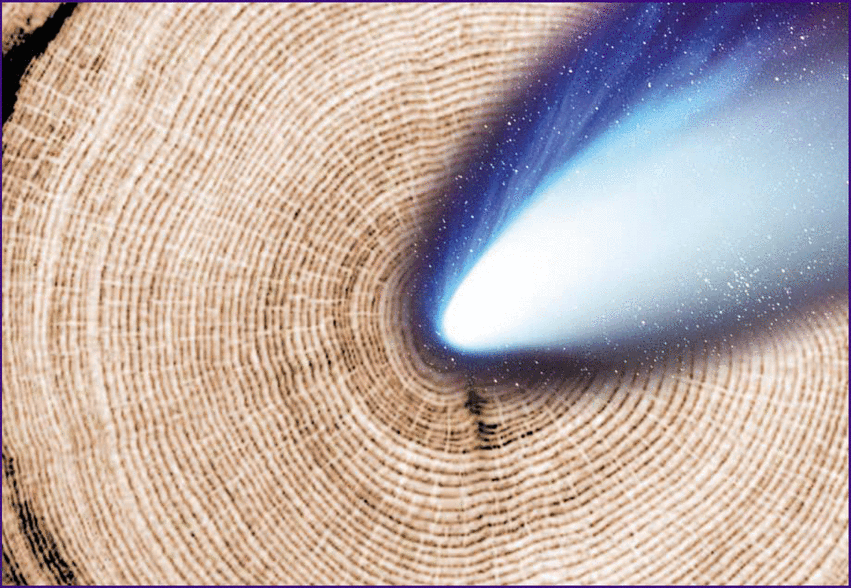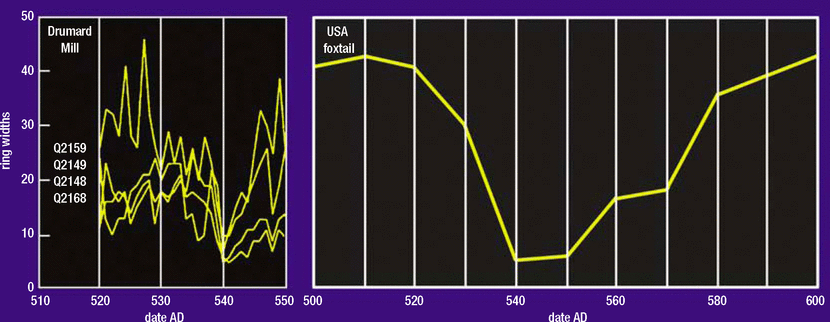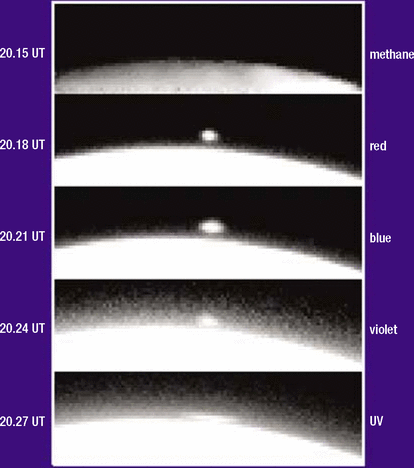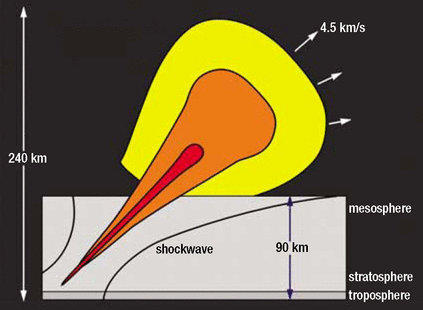A global climatic downturn has previously been observed in tree-ring data associated with the years AD 536ȓ545. We review the evidence for the explanation of this event which involves a comet fragment impacting the Earth and exploding in the upper atmosphere. The explosion would create a plume, such as was seen during the impact of comet Shoemaker-Levy 9 with Jupiter. The resulting debris deposited by the plume on to the top of the atmosphere would increase the opacity and lower the temperature. We calculate the size of the comet required, and find that a relatively small fragment of only about half a kilometre in diameter could be consistent with the data. We conclude that plume formation is a by-product of small comet impacts that must be added to the list of significant global hazards posed by near-Earth objects.
The Earth is bombarded every day by debris from space. The majority of this debris takes the form of very small particles of dust. These objects are known as meteoroids which, as they run into the Earth's atmosphere, produce meteors − also known as shooting stars. Such objects are rarely hazardous. However, there are also much less frequent collisions with larger objects ranging in size from tens of metres to kilometres across, which may be asteroids or comets. Asteroids are primarily rocky or metallic in composition, whereas comets are composed mainly of a variety of ices with some rock. Objects of this size are generally more of a hazard. In fact, the UK government even set up a Near Earth Object Task Force to evaluate the risks of impacts from such objects (Atkinson et al. 2000). Depending on the size and strength of the material of the meteoroid, it may explode in the atmosphere before reaching the ground. Such an event is known as an airburst. An airbursting object releases energy in the form of a shockwave, which can devastate large areas and trigger forest fires. Airbursts can also produce a high-altitude haze of particles, such as was seen in the 1908 Tunguska event.
The AD 536 event
In AD 536 an event occurred which caused significant climatic change. Dendrochronological (tree-ring) evidence in oak trees salvaged from Irish peat bogs indicates a sequence of colder than average summers at this time (Baillie 1991, 1999). A similar effect is seen in Fennoscandian pine trees (Briffa et al. 1990), and a study of European oak tree data as a whole shows that the event starts in 536 and lasts until 545 (Baillie 1994). Figure 1 shows the typical variation in tree-ring widths.


"the Sun gave forth its light without brightness, like the Moon, during this whole year, and it seemed exceedingly like the Sun in eclipse",and Michael the Syrian (Chabot 1901) states:
"the Sun was dark and its darkness lasted for eighteen months; each day it shone for about four hours, and still this light was only a feeble shadow".The sixth-century British monastic writer Gildas talks of large-scale fires and widespread destruction of the landscape at around the same time (Winterbotham 1978). Previously Gildas has been thought to have been talking allegorically, with his many biblical references. However, he may have been describing the actual events taking place at this time.
There have been two theories put forward to account for this cataclysmic climatic event. One idea is that a giant "super-volcano" erupted in 536, causing the effects described above (Stothers 1984, Keys 1999). The alternative scenario invokes an impact by an asteroid or comet (Clube and Napier 1984).
The super-volcano theory has several problems. Firstly, no terrestrial volcano can be satisfactorily identified with this event. Secondly, a super-volcano would be expected to produce significant acidity in the atmosphere. This acidity would be recorded in the polar ice caps. Numerous ice-core studies have been carried out in both Greenland and Antarctica (see, for example, Clausen et al. 1997, Hammer et al. 1997). None of these has found evidence for a significant acid layer around 536 of the sort that would be caused by the eruption of a super-volcano.
There are small acid layers associated with 528 and 533, but they are not sufficiently strong that they can be related to a super-volcano (Clausen et al. 1997). In addition there is an Antarctic ice acid layer dated as 504±40 (Hammer et al. 1997), which has been argued could be related to the 536 event (Keys 1999). However, once again this is not the depth of layer that one would expect of a super-volcano (Baillie 1999). Other measurements have proved inconclusive. For example, in one case an ice core broke up across the crucial period (Zielinski et al. 1994) and in another the exact dating proved controversial (Hammer 1984).
The scenario involving an impact by an asteroid or comet may have seemed far-fetched at one time, but recent scientific evidence indicates that such impacts may be more common than was once believed. The impact of comet Shoemaker-Levy 9 (SL9) with Jupiter in 1994 provided dramatic and direct evidence of the damage that even quite small impacts can generate. Figure 3 shows an example of some images of the SL9 impact event. In addition, the impact of a comet or asteroid is now believed to be responsible for the considerable climatic changes at the end of the Cretaceous period (Alvarez et al. 1980).

No known impact crater can be linked to the 536 event so, if it were due to a comet collision, then the crater may lie unrecognized in a region such as the seabed (unlikely, given that the seabed has now been very well surveyed), or else the comet must have been destroyed in an airburst. If the airburst had sufficient energy to ignite one or more large-scale forest fires (Hills and Goda 1993, Adushkin and Nemchinov 1994), we can calculate whether the soot emissions from these fires were sufficient to cause the observed climatic effects.
During the Cold War much effort went into modelling the secondary effects of a conflict involving nuclear weapons, including large-scale fires and related atmospheric effects, referred to collectively as a nuclear winter (see, for example, Turco et al. 1983, 1990, Crutzen and Birks 1992). The basic hypothesis is that the extensive fires started by nuclear explosions would generate a sufficiently large quantity of soot in the upper atmosphere to affect its radiation balance and cause a change in the Earth's albedo. The net result is reduced solar heating at the Earth's surface and hence a lower temperature. This would produce significantly colder summers and hence reduced tree-ring growth. We can use such models to study fires started by a comet impact, since they provide estimates of the soot yields from appropriate masses of relevant flammable materials. We choose the model of Turco et al. (1990) to make our comparison. This model finds that ~1011 kg of soot injected into the troposphere is sufficient to produce the effect known as a nuclear winter.
It has been found that airbursting comets can start fires more easily than asteroids (Hills and Goda 1993). This occurs because comets tend to dissipate their energy higher in the atmosphere, which has two main effects. The high-altitude energy dissipation allows them to illuminate a much larger area of the Earth. Simultaneously the high altitude of the airburst makes it more difficult for the associated atmospheric shockwaves to reach the Earth's surface and blow out the fire. We note that calculations on the size of an impacting comet required to ignite pine forests show that an object radius of more than 100 m is needed for such an ignition, setting an effective lower limit.
Dendrochronological data and historical records indicate that Northern Europe is the most likely geographical location for the impact (Baillie 1999). However, we note that this suggestion is not critical to the model of large-scale fires, and any equivalent land area would suffice, provided that it was appropriately forested. In the sixth century Europe's most flammable species of tree was the pine tree and forests in Northern Europe were largely composed of pine trees (Rackham 1993), so a forest fire there is possible. A study of fire behaviour from large-scale biomass burning (Einfeld et al. 1991) provides the following equation for the amount of smoke injected into the troposphere by large-scale forest fires:(equation 1)
where MX is the mass yield of a particular gaseous or particulate species X, MF is the fuel load in terms of mass per unit area, AB is the area burned, FC is the fractional consumption of the total fuel load and EX is the emission factor for the species of interest. We can use this equation to estimate what size of forest fire would have been required to produce the cooling recorded in the dendrochronological data.
To calculate MF we assume one tree per hundred square metres of forest (Rackham 1993), which when combined with a typical tree mass gives a fuel load of MF~ 20 kg m-2. For EX we take a value of 1% (Turco et al. 1990) and for the fractional consumption FC we assume 10%. Inserting these values into equation 1, we find that we would need a forest fire to cover the whole of Northern Europe (~5 × 1012 m2) to inject into the troposphere the ~1011 kg of soot required by the nuclear winter model described above. Such a large conflagration seems somewhat unlikely as there would almost certainly have been some form of historical or archaeological record of such a fire. Furthermore, the climatic effects may not last for the time required by the tree-ring data, since soot in the troposphere has a tendency to precipitate out. Consequently, forest fires may have added to the events of 536, but they cannot explain all of the data.
Atmospheric plumes
When comet SL9 broke up into many pieces and collided with Jupiter in 1994, astronomers had their first opportunity in modern times to study in detail a large comet impact with a planet. Many previously unpredicted effects were seen, including giant plumes above the impact sites and huge scars where each fragment had hit. This led several people to model in detail the effects of such collisions. The similarity was noted between the impact of SL9 with a largely gaseous body such as Jupiter and the airburst of a comet impacting the Earth.
Figure 4 shows some results from a model of a 15 megaton equivalent yield comet airburst over the Earth (Boslough and Crawford 1997). The comet plunges into the upper atmosphere, leaving an effectively hollow tube behind it, where it has been, and into which the surrounding air has not yet had time to diffuse. This tube then acts rather like a gun barrel, focusing much of the energy of the airburst explosion along the tube and carrying with it much of the comet debris. This is what causes the observed plume, as material is fired along the tube by the force of the explosion.

An eye-witness drawing of the Tunguska event actually resembles the model plume of figure 4, and many witnesses across northern Russia and Europe noted that the sky was light at night for a few days afterwards. This effect can be explained as noctilucent clouds caused by material from the plume.
The size of the comet
There was no significant global cooling in 1908 so any comet required to explain the 536 event must be larger than the comet which exploded in the air over Tunguska. The best estimate for the size of the Tunguska comet is a few tens of metres in diameter. We can use the model illustrated in figure 4, together with an estimate of the optical depth of the 536 dust veil, to calculate the size of comet fragment required to cause the 536 event.
The dry-fog event noted in the Mediterranean area has been estimated from the description of the Sun to correspond to an optical depth of ~2.5 (Stothers 1984). However, we would question this estimate. It was based purely on assumptions of what was meant in historical records by "the Sun appearing like the Moon" and hence by how much this implied the Sun had dimmed. We can make alternative estimates based on the tree-ring data, which require a decrease in temperature of only up to ~3 °C (Briffa et al. 1990, Scuderi 1990).
The temperature of the Earth's surface, TE, is proportional to LI1/4, where LI is the incident luminosity at the surface of the Earth. If the dust veil had an optical depth of τ then LI would be decreased by e-τ and the temperature at the Earth's surface under the dust veil, TD, is given by (equation 2): Taking TE≈ 300 K and using the maximum temperature decrease of 3 K, we calculate the maximum value required for τ is ~0.04, which is considerably less than the previous estimate.
We make the assumption that the entire mass of the comet is destroyed in the airburst and ejected via the plume. Thereafter the dust condenses out and is deposited on to the top of the atmosphere as small particles of dusty debris. This debris is then spread around the globe roughly uniformly. The dust-to-gas mass ratio in a comet can range from ~0.1 to 10 (see, for instance, Weiler et al. 2003 and references therein), so we take a value of order unity (i.e. Mdust≈ 0.5 Mcomet).
The optical depth τ is then related to the number of dusty particles Nd by the equation (3): where a is the typical radius of a particle and RE is the radius of the Earth. Nd is simply given by the ratio of the dust mass of the comet to the mass of a dusty particle. Hence Nd is given by the ratio of the comet density to the dust particle density (a factor ~0.5 − see, for example, Fitzsimmons et al. 1996, and references therein), multiplied by the fraction of the comet's mass that is dust (~0.5), multiplied by the ratio of the cube of the comet radius RC to the particle radius a. Thus (equation 4): and the comet radius is given by ( equation 5): We know the radius of the Earth (6.4×106 m) and we assume a typical particle radius to be similar to that of particles in the interstellar medium of ~10-6 m (e.g. Fitzsimmons et al. 1996). Hence we find that a τ of 0.04 requires a comet radius of only ~300 m.
Clearly such calculations contain many approximations and assumptions. Some of the numbers that go into this estimate are rather uncertain. We particularly note that we are relying on atmospheric effects to spread the dust evenly over the top of the atmosphere. Nonetheless, the result is interesting. It puts the comet size as intermediate between the Tunguska comet and SL9 and makes it significantly smaller than the comet thought responsible for the dinosaur extinction.
A comparison between the 536 event and the SL9 impact with Jupiter can provide a useful cross-check to our size calculations. The fragments of SL9 that collided with Jupiter ranged in diameter from 300 m to 2 km. The scars created on Jupiter were typically about the size of the Earth or larger. This appears to corroborate our basic premise that a relatively small fragment could have been responsible for the 536 event. We note that a collision with a comet or asteroid of this size has been predicted to occur on the Earth once in several thousand years (Morrison et al. 1994). Consequently we should not be surprised to find evidence for such an impact within the 7000-year dendrochronological record.
Conclusions
The surprising result of these calculations is just how small a comet fragment we have estimated was needed to cause the observed effects. A comet less than a kilometre in diameter has not been previously considered to represent a global hazard (as opposed to a local hazard), let alone one half a kilometre across. For example, the UK government's Near Earth Object Task Force classified impacts from objects in the size range 300−1500 m to be a "large sub-global hazard" (Atkinson et al. 2000) and only recommended monitoring programmes of near-Earth objects greater than a kilometre in size. Yet our estimates show that if plume formation is a common by-product of cometary airbursts (as is believed to be the case), then a relatively small comet fragment can have a global effect.
A possible origin for this object could be the Taurid meteor stream. This stream is the result of the fragmentation of a much larger comet some 20 000 years ago (Bailey et al. 1990). The Earth passes through the Taurid stream in November and June each year, resulting in regular meteor showers normally consisting of microscopic dust particles. A fragmentation of the stream is thought to have occurred around 500 (Clube and Napier 1984). It is possible that a fragment could then have collided with the Earth as it passed through the beta portion of the stream early in 536, causing the atmospheric dust-veil event.
One other historical aspect of the period around 536 may also be significant. This period coincides with a mass population decrease in Europe. This is commonly known as the Justinian Plague, and is believed to be the first appearance of the Black Death in Europe (Russell 1968). The relevance to our hypothesis is that crop failures for several years in a row while the dust veil was present may have caused widespread starvation, leading to an increased susceptibility to disease among the remaining population. Small comets had previously been thought to be less hazardous than small asteroids, but our estimates show that a small comet fragment can have a global effect.
If such an event happened today, and crops failed over a significant part of the globe for several consecutive years, then once again a large percentage of the world's population would face starvation.
Footnotes
- The authors thank Mike Baillie, Mark Bailey, Martin Johnson, Ted Johnson-South and David Williams for interesting and helpful discussions.
Emma Rigby, Melissa Symonds and Derek Ward-Thompson review the evidence for the possibility that a comet may have impacted the Earth in historical times, and discuss the size of the putative comet.
Adushkin V V, Nemchinov I V. Hazards Due to Comets and Asteroids. Gehrels T, et al. , editors. Univ. of Arizona Press; 1994. p. 721-73.
Atkinson H, et al. Near Earth Object Task Force Report. HMSO; 2000.
Alvarez L W, et al. Science 1980;208:1095-108.
Bailey M E, et al. The Origin of Comets. Pergamon Press; 1990.
Baillie M G L. World Archaeology 1991;23:233-43.
Baillie M G L. The Holocene 1994;4:212-17.
Baillie M G L. Exodus to Arthur. Batsford; 1999.
Boslough M R E, Crawford D A. Ann. New York Acad. Sc. 1997;822:236-82.
Briffa K R,et al. Nature 1990;346:434-39.
Chabot J B. Chronicle Belles-Lettres 1901.
Clausen H B, et al. J. Geophys. Res. 1997;102:707-24.
Clube S V M, Napier W M. MNRAS 1984;211:953-68.
Crutzen P J, Birks J W. Ambio 1992;11:114-25.
D'Arrigo R, et al. Geophys. Res. Lett. 2001;28:543-46.
Dewing B H. History of the Wars. Harvard University Press; 1916.
Einfeld W,et al. Global Biomass Burning, Atmospheric, Climatic, and Biospheric Implications. Levine J , editor. MIT Press; 1991. p. 412-20.
Fitzsimmons A,et al. MNRAS 1996;278:781-86.
Hammer C U. Jokull 1984;34:51-56.
Hammer C U,et al. Climatic Change 1997;35:1-15.
Hills J G,Goda M P. Astron. J. 1993;105:1114-44.
Keys D. Catastrophe: an Investigation into the Origins of the Modern World. Century; 1999.
La Marche V C. Science 1974;183:1043-48.
Morrison D,et al. Hazards Due to Comets and Asteroids. Gehrels T, et al. , editors. Univ. of Arizona Press; 1994. p. 59-91.
Rackham O. Trees and Woodland in the British Landscape. Orion Publishing; 1993.
Russell J C. Demography 1968;5:174-84.
Scuderi L A. Quaternary Research 1990;34:67-85.
Scuderi L A. Science 1993;259:1433-36.
Stothers R B. Nature 1984;307:344-45.
Turco R P, et al. Science 1983;222:1283-90.
Turco R P,et al. Science 1990;247:166-75.
Weiler M, et al. A&A 2003;403:313-22.
Winterbotham M. Gildas: The Ruin of Britain and Other Works. Phillimore; 1978.
Zielinski G A, et al . Science 1994;264:948-52.








Excellent article, but there are a few problems. Any object casting large amount of material
would have produce a dust layer in ice cores. No mention of the Gulf of Carpentaria impact
theory. an impact in that area would explain much the what happened. IMHO...
Large amount of moisture in the atmosphere could explain the fog and darkness. This
would have largely destroyed convection, preventing rain and leading to fires. If the fires were caused by direct effects
other connected impact phenomena might have been reported